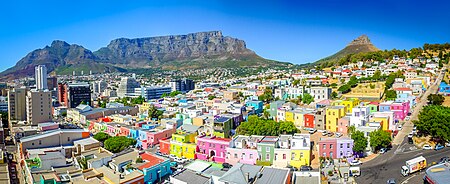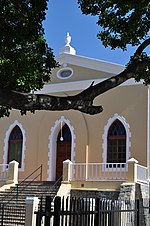Bo-Kaap

The Bo-Kaap (lit. "above the Cape" in Afrikaans) is an area of Cape Town, South Africa formerly known as the Malay Quarter. It is a former racially segregated area, situated on the slopes of Signal Hill above the city centre and is a historical centre of Cape Malay culture in Cape Town. The Nurul Islam Mosque, established in 1844, is located in the area. Bo-Kaap is known for its brightly coloured homes and cobble stoned streets. The area is traditionally a multicultural neighbourhood, and 56.9% of its population identify as Muslim. According to the South African Heritage Resources Agency, the area contains the largest concentration of pre-1850 architecture in South Africa, and is the oldest surviving residential neighborhood in Cape Town.
Excerpt from the Wikipedia article Bo-Kaap (License: CC BY-SA 3.0, Authors, Images).Bo-Kaap
Helliger Lane, Cape Town Bo-Kaap
Geographical coordinates (GPS) Address Nearby Places Show on map
Geographical coordinates (GPS)
| Latitude | Longitude |
|---|---|
| N -33.920833333333 ° | E 18.415277777778 ° |
Address
Helliger Lane
Helliger Lane
8018 Cape Town, Bo-Kaap
Western Cape, South Africa
Open on Google Maps










